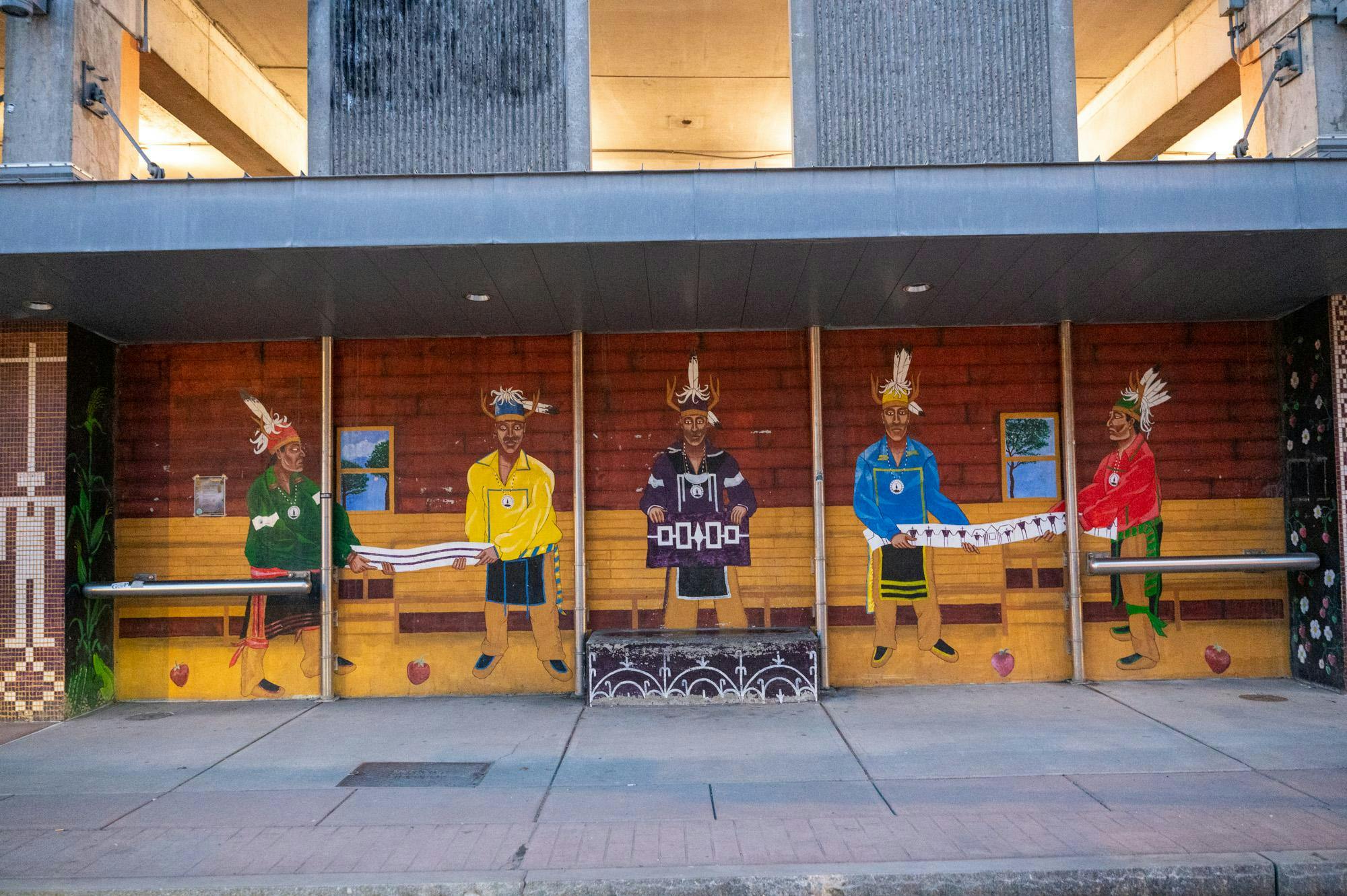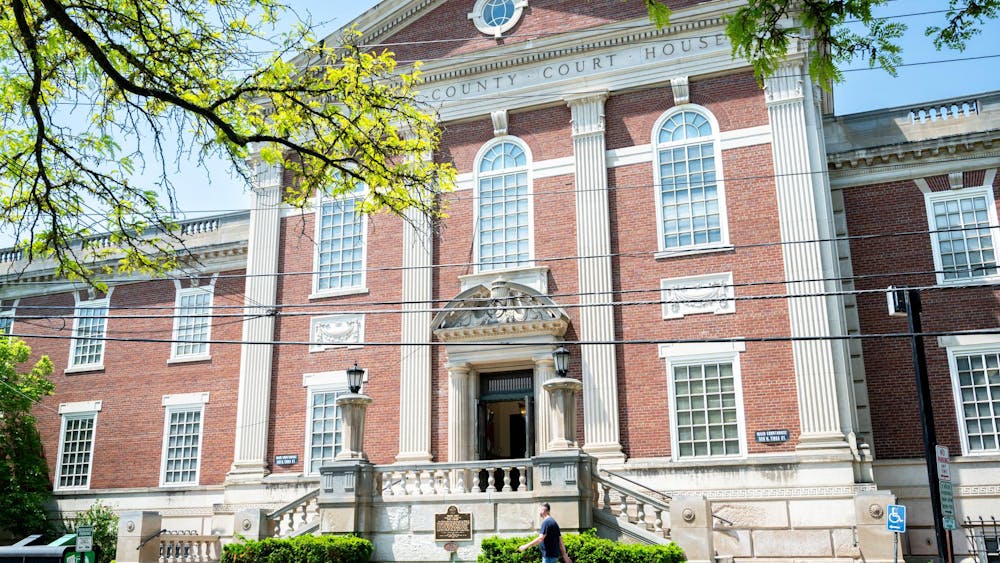A Haudenosaunee-Dutch treaty. A form of martial arts. Mentorship program participants. Marine biology. These are the focus of four of over 400 vibrant murals that together embellish nearly every street in Ithaca.
Each mural contains intricate details that tell a unique story, from historical events to environmental protection.
The Sun spoke with four artists about the inspirations behind a few of Ithaca’s many murals.
“Two Row Wampum 400 Year Anniversary” by Brandon Lazore

A mural painted on the Seneca Street Garage honors the 400-year anniversary of the Two Row Wampum.
On Seneca Street Garage, community members get a snapshot of Native American history through artist Brandon Lazore’s mural, “Two Row Wampum 400 Year Anniversary.”
Lazore is a member of the Snipe Clan from the Onondaga Nation. During his childhood, he split his time between Syracuse, where he was inspired by local graffiti, and the Onondaga Nation reservation.
“I just fell in love with [painting]. I was just like, ‘Wow, this is it,’” Lazore said. “A lightbulb went off.”
Lazore painted the mural in 2013 to commemorate the 400-year anniversary of the Two Row Wampum — the first treaty between the Haudenosaunee and the Dutch in 1613.
The white belt with purple stripes, depicted on the left side of the mural, was used to record the treaty as the Haudenosaunee people did not use paper. Lazore explained that one purple stripe “would be the European vessel and one would be the canoe of the Haudenosaunee people.”
“We were supposed to go down the river of life together and not try to rule over one another,” Lazore said. “We would live amongst each other as equals, as brothers.”
Two columns bookend the mural — they illustrate two belts: the Prophecy Belt and the Ever-Growing Tree Wampum Belt. The Prophecy Belt is portrayed on the left column and pictures the Peacemaker, a prophet who helped form the Haudenosaunee Confederacy. On the right column, the Ever-Growing Tree Wampum Belt represents peace from “the ground all the way up to the sky world,” Lazore said.
On the right side, two people hold the George Washington Belt, which George Washington commissioned himself. The belt represents the unity of the 13 colonies and the Seneca and Mohawk nations.
Through his mural, Lazore hopes to inspire people to learn more about the Indigenous people who originally lived in the area.
“I hope that the people who knew about it would appreciate it, and for the people who didn't know about it would raise a question like, ‘Wow, what does that mean?’ And understand and learn about the people that are originally from these homelands,” Lazore said.
“Aikido” by Melody Often
A mural depicts two people practicing Aikido, a harmonious form of martial art. (Courtesy of Melody Often)
An energetic portrayal of Aikido by artist Melody Often coats a wall of the Dryden Road garage.
Aikido is a form of martial art that emphasizes harmonization with the opponent with the goal of a peaceful resolve. Often said that she felt inspired by the actual act of Aikido, noting the interaction between each participant.
Originally from Schenectady, New York, Often came to Ithaca with the desire to contribute to the city's many murals.
Often said that the mural is from a real-life photograph of her friend and her friend’s husband practicing Aikido together. “I was just so inspired by her,” Often said.
“There's just something so profound about Aikido itself, which is utilizing the energy of your opponent,” Often said. “It's a weirdly peaceful element, so when I saw that image of her, I instantly was inspired and I wanted to throw it up on the wall.”
“Living Now” by Sam Meyerson
A mural depicts the vibrance and diversity of homeless and at-risk youth. (Courtesy of Sam Meyerson)
Artist Sam Meyerson painted his mural, “Living Now,” on the wall of The Learning Web, a mentoring program for youth who are homeless or at risk, in 2019.
Meyerson, from Hudson, New York, knew little of Ithaca before working on the mural, but he was excited for the opportunity to be a part of the city’s already established art scene.
“I [had] actually never been to Ithaca,” Meyerson said. “I really wanted to just take a drive and explore it. I didn't know anything about it, but there was graffiti and art happening.”
The characters depicted in his mural are youth from The Learning Web who helped Meyerson complete the project. It was Meyerson’s intention to have the mural serve as a true, accurate representation of the individuals who make up The Learning Web.
“These kids, with their stylish clothing in cool poses, are all colors, all genders and whatever sexualities. It was an actual representation of The Learning Web,” Meyerson said.
The “living now” quote that takes up a majority of the wall space is a lyric from the song “This is America” by Childish Gambino.
“That’s what we’re doing,” Meyerson said. “We’re living now. We’re not dying.”
“Living Waters” by Lynn Golan
Artist Lynn Golan stands near her water-inspired contribution to Ithaca's mural scene. (Courtesy of Lynn Golan)
Artist Lynn Golan painted a mural titled “Living Waters” on the Dryden Road Garage.
Before she even began painting the mural, Golan said water was on her mind.
“I wanted [the mural] to be near water and I was really thinking a lot about water at that time,” Golan said. “I was really inspired by the work of Dr. Sylvia Earle. She is a really cool marine biologist.”
Golan is fascinated by Earle’s work and the ecology of local marine biology. She used her mural as an opportunity to lay out the interconnectedness of all waterways.
“Ecology is really fascinating to me, thinking about how we're all connected through water,” Golan said. “So I was connecting the lake, ocean marine wildlife to the waterfalls and creeks and streams of Ithaca in the Finger Lakes region.”
The individual in the mural is Leah Penniman of Soul Fire Farm. On the farm, Penniman dedicates much of her work to sustainable agriculture.
“I brought in the woman's face, Leah Penniman, to connect the human and the nature element,” Golan said. “We are in this together, and I am so inspired by Penneman's work as well, and wanted to uplift her work and how that connects because farming affects soil health and water runoff.”
Golan said that she hopes viewers of the mural understand that water is an essential asset that needs to be protected.
“I hope that the piece inspires people to think about our connection to water,” Golan said. “Water is life and is the foundation of life and we gotta take care of our waters.”

Dalton Mullins is a member of the Class of 2027 in the College of Agriculture and Life Sciences. He is a senior writer for the News department and can be reached at dmullins@cornellsun.com.











